|
Baconao Park
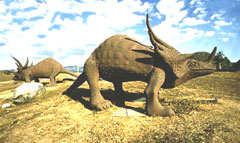 Only 20 kilometres away from the city of Santiago de Cuba and some 80 000 hectares of surface area is Baconao Park, penetrating in Guantánamo’s territory. The visitor is awed by the variety of spots to discover and explore, among them beaches, historical and natural sites, unique museums, as well as a variety of restaurants and cafeterias.
Created in 1981, it features several tourist attractions as the Great Stone (Gran Piedra) and the Siboney Farm (Granjita Siboney), where the attracters of the Moncada Garrison (cuartel Moncada) led by Fidel Castro, spent the night prior to the attack on July 26th of 1953.
Also of interest are the Prehistoric Valley (Valle de la Prehistoria), the Museum of Images (Museo de la Imagen), as well as the History of Terrestrial Transport Museum, with over 2 500 reduced scale replicas. Do not miss a place well worth visiting, the House of Lame Pedro (a Casa de Pedro El Cojo) where the best tasting native “criolla” food is served.
Only 20 kilometres away from the city of Santiago de Cuba and some 80 000 hectares of surface area is Baconao Park, penetrating in Guantánamo’s territory. The visitor is awed by the variety of spots to discover and explore, among them beaches, historical and natural sites, unique museums, as well as a variety of restaurants and cafeterias.
Created in 1981, it features several tourist attractions as the Great Stone (Gran Piedra) and the Siboney Farm (Granjita Siboney), where the attracters of the Moncada Garrison (cuartel Moncada) led by Fidel Castro, spent the night prior to the attack on July 26th of 1953.
Also of interest are the Prehistoric Valley (Valle de la Prehistoria), the Museum of Images (Museo de la Imagen), as well as the History of Terrestrial Transport Museum, with over 2 500 reduced scale replicas. Do not miss a place well worth visiting, the House of Lame Pedro (a Casa de Pedro El Cojo) where the best tasting native “criolla” food is served.
For more information:
www.cuba-santiagodecuba.com
|
|
|
BACUNAYAGUA BRIDGE
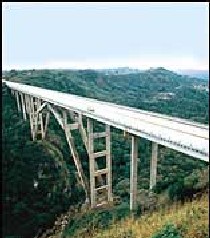 This bridge marks the territorial limit by way of the Via Blanca Highway of the provinces of Havana and Matanzas, and so both territories squabble for this genuine jewel of Cuban architecture of an extension of 114 metres and heights of around 110 metres.
The construction was finished in 1960 and the arch of the bridge was made out of laminated metal, set up in two sections, each one turning until they were locked in their permanent position. The girders weigh at least 47 tonnes each.
It can be considered the most complex and daring construction of its type in Cuba. The main architect was the engineer Luis Saenz Duplace.
This bridge marks the territorial limit by way of the Via Blanca Highway of the provinces of Havana and Matanzas, and so both territories squabble for this genuine jewel of Cuban architecture of an extension of 114 metres and heights of around 110 metres.
The construction was finished in 1960 and the arch of the bridge was made out of laminated metal, set up in two sections, each one turning until they were locked in their permanent position. The girders weigh at least 47 tonnes each.
It can be considered the most complex and daring construction of its type in Cuba. The main architect was the engineer Luis Saenz Duplace.
For more information:
www.cuba-giron.com
,
www.cuba-guama.com
,
www.cuba-matanzas.com
,
www.cuba-cienagadezapata.com
,
www.cuba-playagiron.com
,
www.cuba-playalarga.com
|
|
|
BIRTH HOUSE OF JOSÉ ANTONIO ECHEVERRÍA
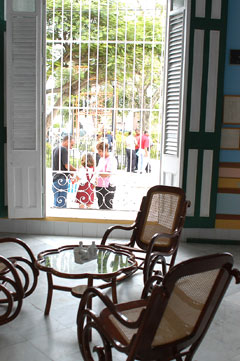 It is located on Genas St. No.560 between Calzada and Colonel Verdugo, municipality of Cárdenas, only 10 miles away from the famous beach of Varadero.
This cultural institution was declared a National Monument since 1971 due to its historical and architectural values. Inside the building there are 983 objects on exhibit.
It has nine rooms, one of them decorated in a way that recreates the childhood period of José Antonio, exhibiting furniture that although did not originally belong to the family, it does date from that time.
Also quite notable for the visitor is the painter’s palette that he used as a child, his notebook with the addresses of envelope collectors, as well as the Chrysler automobile, manufactured in 1954 which he used for smuggling rifles and revolutionaries, while studying Architecture in the University of Havana, during the struggle against the regime of Fulgencio Batista.
It is located on Genas St. No.560 between Calzada and Colonel Verdugo, municipality of Cárdenas, only 10 miles away from the famous beach of Varadero.
This cultural institution was declared a National Monument since 1971 due to its historical and architectural values. Inside the building there are 983 objects on exhibit.
It has nine rooms, one of them decorated in a way that recreates the childhood period of José Antonio, exhibiting furniture that although did not originally belong to the family, it does date from that time.
Also quite notable for the visitor is the painter’s palette that he used as a child, his notebook with the addresses of envelope collectors, as well as the Chrysler automobile, manufactured in 1954 which he used for smuggling rifles and revolutionaries, while studying Architecture in the University of Havana, during the struggle against the regime of Fulgencio Batista.
For more information:
www.cuba-heroes.com
,
www.cuba-history.com
,
www.cuba-museums.com
,
www.cuba-matanzas.com
,
www.cubanphotobank.com
|
|
|
CAIMITO DEL HANÁBANA
This area maintains its original name and has a high historical value, due to the fact that it is where the first human settlements were made. As early as 1536 the metropolis donated some portions of land to the Spanish settlers from the Peninsula, where they made their home for many years.
The historical value of this place is outstanding, one of the events that took place here was on October 23rd of 1862, when José Martí at the age of nine, wrote a letter to his mother Doña Leonor Pérez, during his stay in Caimito del Hanábana. This letter was considered the first written work of the master and it is the oldest letter preserved to date.
Caimito del Hanábana is one of the five Captaincies of the Party belonging to the jurisdiction of Colón City, a present day municipality of the province of Matanzas. The visitor can always find an open invitation to encounter the history of this place which is considered a National Monument.
For more information:
www.cuba-history.com
,
www.cuba-josemarti.com
,
www.cuba-literature.com
,
www.cuba-matanzas.com
|
|
|
CAVE OF SANTA CATALINA
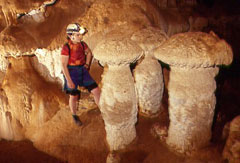 Featuring an attractive environment, this cave is found along the road that leads into the city of Matanzas and to Varadero beach, exactly four kilometres east of the town of Carbonera.
This natural site was declared a National Monument in 1996. It is characterised by eleven kilometres of subterranean galleries and features the most extraordinary secondary formations, especially interesting are the mushrooms, zinolites and aboriginal pictographs.
Nearby, there is another place known as the Cave of the Dead (Cueva del Muerto), right next to the drawbridge of Varadero. It is a cave of great natural and archaeological value, due to the fact that in over eight kilometres of galleries there is ample evidence of pre-Columbian communities and many species of fauna and secondary formations
Featuring an attractive environment, this cave is found along the road that leads into the city of Matanzas and to Varadero beach, exactly four kilometres east of the town of Carbonera.
This natural site was declared a National Monument in 1996. It is characterised by eleven kilometres of subterranean galleries and features the most extraordinary secondary formations, especially interesting are the mushrooms, zinolites and aboriginal pictographs.
Nearby, there is another place known as the Cave of the Dead (Cueva del Muerto), right next to the drawbridge of Varadero. It is a cave of great natural and archaeological value, due to the fact that in over eight kilometres of galleries there is ample evidence of pre-Columbian communities and many species of fauna and secondary formations
For more information:
www.cuba-fauna.com
,
www.cuba-flora.com
,
www.cuba-geography.com
,
www.cuba-history.com
,
www.cuba-varaderobeach.com
,
www.cuba-matanzas.com
|
|
|
CIÉNAGA DE ZAPATA
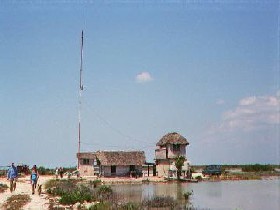 Nature lovers consider this southeast area of Cuba a place well worth visiting, in order to admire its almost virgin forests, blue, clear water beaches, lakes and caverns and natural pools. Thirty percent of the native fauna live here, while of the 171 species of birds, 18 are native to the island. There is also a great variety of crocodiles, reaching some 15 000 individuals, as well as the manatee, considered a jewel of the national fauna.
The International Bird Observation Centre (Centro Internacional de Observación de Aves) is located at Playa Larga, with some 400 metres of warm water with coral bottoms and natural trails.
The tourist centre of Guamá, is an aborigine construction where the work of the famous Cuban sculptress Rita Longa can be appreciated in all its magnitude. Giron Beach (Playa Girón), in 1961, marked the defeat of the mercenary troops paid by the United States who invaded Cuba here.
Nature lovers consider this southeast area of Cuba a place well worth visiting, in order to admire its almost virgin forests, blue, clear water beaches, lakes and caverns and natural pools. Thirty percent of the native fauna live here, while of the 171 species of birds, 18 are native to the island. There is also a great variety of crocodiles, reaching some 15 000 individuals, as well as the manatee, considered a jewel of the national fauna.
The International Bird Observation Centre (Centro Internacional de Observación de Aves) is located at Playa Larga, with some 400 metres of warm water with coral bottoms and natural trails.
The tourist centre of Guamá, is an aborigine construction where the work of the famous Cuban sculptress Rita Longa can be appreciated in all its magnitude. Giron Beach (Playa Girón), in 1961, marked the defeat of the mercenary troops paid by the United States who invaded Cuba here.
For more information:
www.cuba-giron.com
,
www.cuba-guama.com
,
www.cuba-matanzas.com
,
www.cuba-cienagadezapata.com
,
www.cuba-playagiron.com
,
www.cuba-playalarga.com
|
|
|
CROCODILE NURSERY (CRIADERO DE COCODRILOS)
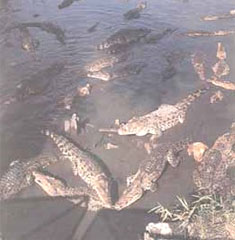 To visit this unique place allows one to meet the brave people that work on developing the species, after stopping the accelerated process of the crocodile’s disappearance in Cuba.
This nursery, the largest in the country, located in the Zapata Swamps (Ciénaga de Zapata), is one of the best-preserved areas regarding its flora and fauna. It covers a surface area of some 600 square kilometres, and thousands of Cuban species dwell within it.
It is located in an area called The Mouth (La Boca), which is part of the tourist centre of the Ciénaga, which includes a Taino Village (aldea taína), the Treasure Lagoon (Laguna del Tesoro) which offers abundant fishing among other attractions. The crocodiles are tended to by veterinarians and other specialists, who release them with other inhabitants of the swamps when they are of an age to do so.
To visit this unique place allows one to meet the brave people that work on developing the species, after stopping the accelerated process of the crocodile’s disappearance in Cuba.
This nursery, the largest in the country, located in the Zapata Swamps (Ciénaga de Zapata), is one of the best-preserved areas regarding its flora and fauna. It covers a surface area of some 600 square kilometres, and thousands of Cuban species dwell within it.
It is located in an area called The Mouth (La Boca), which is part of the tourist centre of the Ciénaga, which includes a Taino Village (aldea taína), the Treasure Lagoon (Laguna del Tesoro) which offers abundant fishing among other attractions. The crocodiles are tended to by veterinarians and other specialists, who release them with other inhabitants of the swamps when they are of an age to do so.
For more information:
www.cuba-fauna.com
,
www.cuba-matanzas.com
|
|
|
FUERTE EL MORRILLO
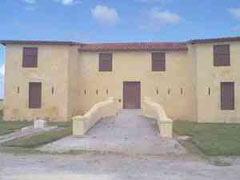 Declared a National Monument in 1978, it is a preserved military construction at the mouth of the Canimar River, in the city of Matanzas.
It is located in one of the fortresses that protected the city from the constant attacks of pirates, and it adopted its present day look around 1830.
Pieces of aborigine archaeology are on exhibit, since the fortress was constructed in the middle of the largest settlement of Cuba’s first inhabitants.
Two of the patriots that fought for independence: Antonio Guiteras and the Venezuelan Carlos Aponte, chose this place to organise an expedition to Mexico. After being ratted on, they were surprised and murdered on this site on May 8th of 1935.
Declared a National Monument in 1978, it is a preserved military construction at the mouth of the Canimar River, in the city of Matanzas.
It is located in one of the fortresses that protected the city from the constant attacks of pirates, and it adopted its present day look around 1830.
Pieces of aborigine archaeology are on exhibit, since the fortress was constructed in the middle of the largest settlement of Cuba’s first inhabitants.
Two of the patriots that fought for independence: Antonio Guiteras and the Venezuelan Carlos Aponte, chose this place to organise an expedition to Mexico. After being ratted on, they were surprised and murdered on this site on May 8th of 1935.
For more information:
www.cuba-architecture.com
,
www.cuba-heroes.com
,
www.cuba-history.com
,
www.cuba-matanzas.com
|
|
|
GIRON BEACH (PLAYA GIRÓN)
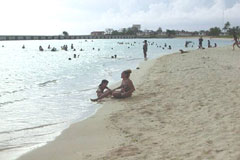 An invasion took place in April of 1961 in the well-known Bay of Pigs (Bahía de Cochinos), financed by the United States, and using elements against the Cuban Revolution. In the landing there were over 1 600 mercenaries, which were defeated in less than 72 hours. That historical event was the United States’ first military defeat in Latin America, and the place still holds many testimonies, as well as live witnesses of the event. Also, there is a museum, located in the ancient Australia sugar mill, where there are valuable declassified CIA (Central Intelligence Agency) documents, as well as weapons and all kinds of artefacts that were seized from over a thousand prisoners.
An invasion took place in April of 1961 in the well-known Bay of Pigs (Bahía de Cochinos), financed by the United States, and using elements against the Cuban Revolution. In the landing there were over 1 600 mercenaries, which were defeated in less than 72 hours. That historical event was the United States’ first military defeat in Latin America, and the place still holds many testimonies, as well as live witnesses of the event. Also, there is a museum, located in the ancient Australia sugar mill, where there are valuable declassified CIA (Central Intelligence Agency) documents, as well as weapons and all kinds of artefacts that were seized from over a thousand prisoners.
For more information:
www.cuba-giron.com
,
www.cuba-history.com
,
www.cuba-matanzas.com
,
www.cuba-playagiron.com
|
|
|
LA DOMINICA BUILDING
Built in 1849 it is located in the Plaza of Cristóbal Colón, where the city of Cardenas was founded and also its political, administrative and cultural centre, very near Varadero Beach.
This building has had several social uses and has witnessed several historical events, some of the most notable being the lodging of the generals of the Mambi army: Máximo Gómez Báez, Antonio Maceo Grajales and Domingo Méndez Capote.
When the city was taken on May 19th of 1850, by the troops of the Venezuelan General Narciso López, there was an exceptional moment in which, for the first time in history, the Cuban flag was raised.
Due to its wealth of historical merits, this building was named a National Monument.
For more information:
www.cuba-history.com
,
www.cuba-matanzas.com
,
www.cubanculture.info
,
www.cuban-culture.com
|
|
|
LA IGNACIA MONUMENT
This monument marks the place where the Independence War of the east was reborn on February 24th of the year of 1895. The event, known as the Cry of Ibarra (Grito de Ibarra) was organised by the National Hero José Martí from his exile and directed in this territory by two great personalities of Cuba’s history: Juan Gualberto Gómez and Antonio López Coloma.
This is a perpetual tribute of remembrance for the legendary fighters of the Island’s freedom against the Spanish colonial yoke.
The present day monument was built in the farmstead of La Ignacia (Finca La Ignacia), a wild spot of much natural beauty that well deserves a visit in the municipality of Limonar, less than 20 kilometres from the city of Matanzas.
Due to its high historical value this place has been declared a National Monument.
Long Text>
For more information:
www.cuba-heroes.com
,
www.cuba-history.com
,
www.cuba-josemarti.com
,
www.cuba-matanzas.com
|
|
|
MATANZAS
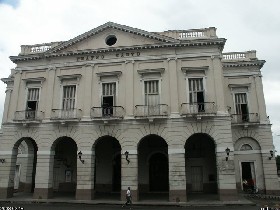 With the name of San Carlos and San Severino of Matanzas it was founded on October 12th of 1693 and today has a surface area of almost 12 000 square kilometres and over 700 000 inhabitants. It is known as the Athens of Cuba.
The city is divided by the San Juan River (río San Juan) and is characterised by its cultural development, whose most significant expression is the Sauto Theatre (Teatro Sauto), where important national as well as international artists have performed.
The city, as well as the province, does not possess important elevations and the soil is fertile. The tercentennial province is only 98 kilometres from the capital, along the way to the famous beach of Varadero, one of the main tourist sites in the country.
Matanzas features a beautiful azure bay, as well as a central city area where parks and buildings, some dating back to the colonial era, coexist in harmony. If you prefer, you can enjoy a sea swim at El Zapato beach that bathes the city’s coastline.
With the name of San Carlos and San Severino of Matanzas it was founded on October 12th of 1693 and today has a surface area of almost 12 000 square kilometres and over 700 000 inhabitants. It is known as the Athens of Cuba.
The city is divided by the San Juan River (río San Juan) and is characterised by its cultural development, whose most significant expression is the Sauto Theatre (Teatro Sauto), where important national as well as international artists have performed.
The city, as well as the province, does not possess important elevations and the soil is fertile. The tercentennial province is only 98 kilometres from the capital, along the way to the famous beach of Varadero, one of the main tourist sites in the country.
Matanzas features a beautiful azure bay, as well as a central city area where parks and buildings, some dating back to the colonial era, coexist in harmony. If you prefer, you can enjoy a sea swim at El Zapato beach that bathes the city’s coastline.
For more information:
www.cuba-giron.com
,
www.cuba-guama.com
,
www.cuba-matanzas.com
,
www.cuba-cienagadezapata.com
,
www.cuba-playagiron.com
,
www.cuba-playalarga.com
|
|
|
Palmar del Junco Stadium
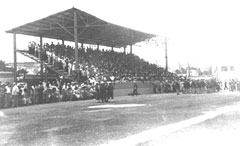 Located in the heart of the city of Matanzas, capital of the province of the same name, it is some 100 kilometres from Havana City. It was built in 1847 and treasures the historical event of Cuba’s first baseball game that took place there in 1874. The Cuban Hall of Fame of this sport has been planned to be created here, due to the historical significance of this stadium, where baseball games have been played in the first National Series after the Revolution’s triumph in 1959, until the games were moved to the new stadium named Victoria de Girón, the present day headquarters of the area’s teams.
Located in the heart of the city of Matanzas, capital of the province of the same name, it is some 100 kilometres from Havana City. It was built in 1847 and treasures the historical event of Cuba’s first baseball game that took place there in 1874. The Cuban Hall of Fame of this sport has been planned to be created here, due to the historical significance of this stadium, where baseball games have been played in the first National Series after the Revolution’s triumph in 1959, until the games were moved to the new stadium named Victoria de Girón, the present day headquarters of the area’s teams.
For more information:
www.cuba-history.com
,
www.cuba-matanzas.com
|
|
|
REMAINS OF THE TRAIL (TROCHA) FROM JÚCARO TO MORÓN
A brief history of the Trail (Trocha) from Júcaro to Morón.
In the wars of 1868 and 1895, the Trocha was an insurmountable barrier, as the Spanish thought, and after it was finished, it became the most perfect and sophisticated military construction that the Spanish Colonialism had in America. Of course it was never a deterrent for the glorious Mambi Army (Ejército Mambí), who in both wars kept crossing it ,showing the ingenious strategies deployed by their military chiefs, among them Máximo Gómez and Antonio Maceo, with the help of other insurrectional chiefs of the area, such as Brigadier José Gómez Cardoso and Colonel Simón Reyes Hernández, known as the Eagle of the Trocha (El Águila de la Trocha).
The aim of this military line was to isolate the mambi forces in the eastern area, in order to deter help and break contact between the insurrectional forces in the central and eastern regions, and to stop the invaders, led by Máximo Gómez and Antonio Maceo from extending the war to the western region of the country, an event that would wear down the strength of Spanish colonialism, leading up to its final fall.
By the end of March of 1871, three years from the Cry of Yara (Grito de Yara), General Blas Villate de la Hera, Count of Valmaseda, proposed to the Overseas Minister of the Spanish Crown; the construction of a trocha or fortified line, from the port of Júcaro, on the southern coast; running across the island, to the settlement of Morón, on the northern coast.
Valmaseda’s proposal was approved, and construction on the trocha was started. It started out with 17 fortresses and in 1874, 16 bunkers had been added on, more than five thousand men were employed to guard it, these soldiers had modern infantry weapons as well as ten pieces of artillery, which were moved along the Trocha by a narrow railway, which also allowed them to quickly move the troops from one end to the other.
For more information:
www.cuba-heroes.com
,
www.cuba-history.com
,
www.cuba-matanzas.com
,
www.cuba-cienfuegos.com
,
www.cuba-villaclara.com
,
www.cuba-sanctispiritus.com
|
|
|
TRIUNVIRATO
This monument erected in memory of the Rebel Slave (Esclavo Rebelde) is found on the land belonging to the ancient sugar mill of Triunvirato, founded in the XIX century, a period in which many sugar mills were set up and started functioning in the Matanzas area.
Precisely here, events of such transcendental importance took place on November fifth of 1843, that they provoked the burst of the greatest rebellion ever in those convulsive times of slavery.
These violent events brought about the initial execution of the foreman, an evil man that had much abused his victims and following that event, the slaves set the whole place on fire, devouring even the last wooden plank of Triunvirato.
This monument speaks for itself. There are more than enough historical reasons for it to have a privileged place among those that are considered National Monuments
For more information:
www.cuba-history.com
,
www.cuba-sugar.com
,
www.cuba-matanzas.com
|
|
|
VARADERO
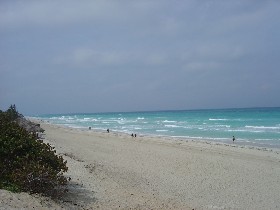 Is considered one of the most beautiful beaches in the world and is located in the Icacos Peninsula with some 22 kilometres of admirable fine white sand beaches and different tones of azure tinted ocean. This area is visited yearly by hundreds of thousands of people from around the world.
All kinds of conditions are available in order to satisfy the most demanding tastes, from its modern international airport “Juan Gualberto Gómez”, up to nearly 15 000 rooms distributed in modern and comfortable hotels operated by the most important Cuban enterprises and other specialised foreign companies.
The exploitation of this tourist attraction began in the decade of 1940, but the exact date of its founding goes back to December 5th of 1887, when ten families settled in the area. Since then, the changes in Varadero are enormous and are in constant evolution.
Is considered one of the most beautiful beaches in the world and is located in the Icacos Peninsula with some 22 kilometres of admirable fine white sand beaches and different tones of azure tinted ocean. This area is visited yearly by hundreds of thousands of people from around the world.
All kinds of conditions are available in order to satisfy the most demanding tastes, from its modern international airport “Juan Gualberto Gómez”, up to nearly 15 000 rooms distributed in modern and comfortable hotels operated by the most important Cuban enterprises and other specialised foreign companies.
The exploitation of this tourist attraction began in the decade of 1940, but the exact date of its founding goes back to December 5th of 1887, when ten families settled in the area. Since then, the changes in Varadero are enormous and are in constant evolution.
For more information:
www.cuba-giron.com
,
www.cuba-guama.com
,
www.cuba-matanzas.com
,
www.cuba-cienagadezapata.com
,
www.cuba-playagiron.com
,
www.cuba-playalarga.com
|
|
 Only 20 kilometres away from the city of Santiago de Cuba and some 80 000 hectares of surface area is Baconao Park, penetrating in Guantánamo’s territory. The visitor is awed by the variety of spots to discover and explore, among them beaches, historical and natural sites, unique museums, as well as a variety of restaurants and cafeterias.
Created in 1981, it features several tourist attractions as the Great Stone (Gran Piedra) and the Siboney Farm (Granjita Siboney), where the attracters of the Moncada Garrison (cuartel Moncada) led by Fidel Castro, spent the night prior to the attack on July 26th of 1953.
Also of interest are the Prehistoric Valley (Valle de la Prehistoria), the Museum of Images (Museo de la Imagen), as well as the History of Terrestrial Transport Museum, with over 2 500 reduced scale replicas. Do not miss a place well worth visiting, the House of Lame Pedro (a Casa de Pedro El Cojo) where the best tasting native “criolla” food is served.
Only 20 kilometres away from the city of Santiago de Cuba and some 80 000 hectares of surface area is Baconao Park, penetrating in Guantánamo’s territory. The visitor is awed by the variety of spots to discover and explore, among them beaches, historical and natural sites, unique museums, as well as a variety of restaurants and cafeterias.
Created in 1981, it features several tourist attractions as the Great Stone (Gran Piedra) and the Siboney Farm (Granjita Siboney), where the attracters of the Moncada Garrison (cuartel Moncada) led by Fidel Castro, spent the night prior to the attack on July 26th of 1953.
Also of interest are the Prehistoric Valley (Valle de la Prehistoria), the Museum of Images (Museo de la Imagen), as well as the History of Terrestrial Transport Museum, with over 2 500 reduced scale replicas. Do not miss a place well worth visiting, the House of Lame Pedro (a Casa de Pedro El Cojo) where the best tasting native “criolla” food is served.
 This bridge marks the territorial limit by way of the Via Blanca Highway of the provinces of Havana and Matanzas, and so both territories squabble for this genuine jewel of Cuban architecture of an extension of 114 metres and heights of around 110 metres.
The construction was finished in 1960 and the arch of the bridge was made out of laminated metal, set up in two sections, each one turning until they were locked in their permanent position. The girders weigh at least 47 tonnes each.
It can be considered the most complex and daring construction of its type in Cuba. The main architect was the engineer Luis Saenz Duplace.
This bridge marks the territorial limit by way of the Via Blanca Highway of the provinces of Havana and Matanzas, and so both territories squabble for this genuine jewel of Cuban architecture of an extension of 114 metres and heights of around 110 metres.
The construction was finished in 1960 and the arch of the bridge was made out of laminated metal, set up in two sections, each one turning until they were locked in their permanent position. The girders weigh at least 47 tonnes each.
It can be considered the most complex and daring construction of its type in Cuba. The main architect was the engineer Luis Saenz Duplace.
 It is located on Genas St. No.560 between Calzada and Colonel Verdugo, municipality of Cárdenas, only 10 miles away from the famous beach of Varadero.
This cultural institution was declared a National Monument since 1971 due to its historical and architectural values. Inside the building there are 983 objects on exhibit.
It has nine rooms, one of them decorated in a way that recreates the childhood period of José Antonio, exhibiting furniture that although did not originally belong to the family, it does date from that time.
Also quite notable for the visitor is the painter’s palette that he used as a child, his notebook with the addresses of envelope collectors, as well as the Chrysler automobile, manufactured in 1954 which he used for smuggling rifles and revolutionaries, while studying Architecture in the University of Havana, during the struggle against the regime of Fulgencio Batista.
It is located on Genas St. No.560 between Calzada and Colonel Verdugo, municipality of Cárdenas, only 10 miles away from the famous beach of Varadero.
This cultural institution was declared a National Monument since 1971 due to its historical and architectural values. Inside the building there are 983 objects on exhibit.
It has nine rooms, one of them decorated in a way that recreates the childhood period of José Antonio, exhibiting furniture that although did not originally belong to the family, it does date from that time.
Also quite notable for the visitor is the painter’s palette that he used as a child, his notebook with the addresses of envelope collectors, as well as the Chrysler automobile, manufactured in 1954 which he used for smuggling rifles and revolutionaries, while studying Architecture in the University of Havana, during the struggle against the regime of Fulgencio Batista.
 Featuring an attractive environment, this cave is found along the road that leads into the city of Matanzas and to Varadero beach, exactly four kilometres east of the town of Carbonera.
This natural site was declared a National Monument in 1996. It is characterised by eleven kilometres of subterranean galleries and features the most extraordinary secondary formations, especially interesting are the mushrooms, zinolites and aboriginal pictographs.
Nearby, there is another place known as the Cave of the Dead (Cueva del Muerto), right next to the drawbridge of Varadero. It is a cave of great natural and archaeological value, due to the fact that in over eight kilometres of galleries there is ample evidence of pre-Columbian communities and many species of fauna and secondary formations
Featuring an attractive environment, this cave is found along the road that leads into the city of Matanzas and to Varadero beach, exactly four kilometres east of the town of Carbonera.
This natural site was declared a National Monument in 1996. It is characterised by eleven kilometres of subterranean galleries and features the most extraordinary secondary formations, especially interesting are the mushrooms, zinolites and aboriginal pictographs.
Nearby, there is another place known as the Cave of the Dead (Cueva del Muerto), right next to the drawbridge of Varadero. It is a cave of great natural and archaeological value, due to the fact that in over eight kilometres of galleries there is ample evidence of pre-Columbian communities and many species of fauna and secondary formations
 Nature lovers consider this southeast area of Cuba a place well worth visiting, in order to admire its almost virgin forests, blue, clear water beaches, lakes and caverns and natural pools. Thirty percent of the native fauna live here, while of the 171 species of birds, 18 are native to the island. There is also a great variety of crocodiles, reaching some 15 000 individuals, as well as the manatee, considered a jewel of the national fauna.
The International Bird Observation Centre (Centro Internacional de Observación de Aves) is located at Playa Larga, with some 400 metres of warm water with coral bottoms and natural trails.
The tourist centre of Guamá, is an aborigine construction where the work of the famous Cuban sculptress Rita Longa can be appreciated in all its magnitude. Giron Beach (Playa Girón), in 1961, marked the defeat of the mercenary troops paid by the United States who invaded Cuba here.
Nature lovers consider this southeast area of Cuba a place well worth visiting, in order to admire its almost virgin forests, blue, clear water beaches, lakes and caverns and natural pools. Thirty percent of the native fauna live here, while of the 171 species of birds, 18 are native to the island. There is also a great variety of crocodiles, reaching some 15 000 individuals, as well as the manatee, considered a jewel of the national fauna.
The International Bird Observation Centre (Centro Internacional de Observación de Aves) is located at Playa Larga, with some 400 metres of warm water with coral bottoms and natural trails.
The tourist centre of Guamá, is an aborigine construction where the work of the famous Cuban sculptress Rita Longa can be appreciated in all its magnitude. Giron Beach (Playa Girón), in 1961, marked the defeat of the mercenary troops paid by the United States who invaded Cuba here.
 To visit this unique place allows one to meet the brave people that work on developing the species, after stopping the accelerated process of the crocodile’s disappearance in Cuba.
This nursery, the largest in the country, located in the Zapata Swamps (Ciénaga de Zapata), is one of the best-preserved areas regarding its flora and fauna. It covers a surface area of some 600 square kilometres, and thousands of Cuban species dwell within it.
It is located in an area called The Mouth (La Boca), which is part of the tourist centre of the Ciénaga, which includes a Taino Village (aldea taína), the Treasure Lagoon (Laguna del Tesoro) which offers abundant fishing among other attractions. The crocodiles are tended to by veterinarians and other specialists, who release them with other inhabitants of the swamps when they are of an age to do so.
To visit this unique place allows one to meet the brave people that work on developing the species, after stopping the accelerated process of the crocodile’s disappearance in Cuba.
This nursery, the largest in the country, located in the Zapata Swamps (Ciénaga de Zapata), is one of the best-preserved areas regarding its flora and fauna. It covers a surface area of some 600 square kilometres, and thousands of Cuban species dwell within it.
It is located in an area called The Mouth (La Boca), which is part of the tourist centre of the Ciénaga, which includes a Taino Village (aldea taína), the Treasure Lagoon (Laguna del Tesoro) which offers abundant fishing among other attractions. The crocodiles are tended to by veterinarians and other specialists, who release them with other inhabitants of the swamps when they are of an age to do so.
 Declared a National Monument in 1978, it is a preserved military construction at the mouth of the Canimar River, in the city of Matanzas.
It is located in one of the fortresses that protected the city from the constant attacks of pirates, and it adopted its present day look around 1830.
Pieces of aborigine archaeology are on exhibit, since the fortress was constructed in the middle of the largest settlement of Cuba’s first inhabitants.
Two of the patriots that fought for independence: Antonio Guiteras and the Venezuelan Carlos Aponte, chose this place to organise an expedition to Mexico. After being ratted on, they were surprised and murdered on this site on May 8th of 1935.
Declared a National Monument in 1978, it is a preserved military construction at the mouth of the Canimar River, in the city of Matanzas.
It is located in one of the fortresses that protected the city from the constant attacks of pirates, and it adopted its present day look around 1830.
Pieces of aborigine archaeology are on exhibit, since the fortress was constructed in the middle of the largest settlement of Cuba’s first inhabitants.
Two of the patriots that fought for independence: Antonio Guiteras and the Venezuelan Carlos Aponte, chose this place to organise an expedition to Mexico. After being ratted on, they were surprised and murdered on this site on May 8th of 1935.
 An invasion took place in April of 1961 in the well-known Bay of Pigs (Bahía de Cochinos), financed by the United States, and using elements against the Cuban Revolution. In the landing there were over 1 600 mercenaries, which were defeated in less than 72 hours. That historical event was the United States’ first military defeat in Latin America, and the place still holds many testimonies, as well as live witnesses of the event. Also, there is a museum, located in the ancient Australia sugar mill, where there are valuable declassified CIA (Central Intelligence Agency) documents, as well as weapons and all kinds of artefacts that were seized from over a thousand prisoners.
An invasion took place in April of 1961 in the well-known Bay of Pigs (Bahía de Cochinos), financed by the United States, and using elements against the Cuban Revolution. In the landing there were over 1 600 mercenaries, which were defeated in less than 72 hours. That historical event was the United States’ first military defeat in Latin America, and the place still holds many testimonies, as well as live witnesses of the event. Also, there is a museum, located in the ancient Australia sugar mill, where there are valuable declassified CIA (Central Intelligence Agency) documents, as well as weapons and all kinds of artefacts that were seized from over a thousand prisoners.
 With the name of San Carlos and San Severino of Matanzas it was founded on October 12th of 1693 and today has a surface area of almost 12 000 square kilometres and over 700 000 inhabitants. It is known as the Athens of Cuba.
The city is divided by the San Juan River (río San Juan) and is characterised by its cultural development, whose most significant expression is the Sauto Theatre (Teatro Sauto), where important national as well as international artists have performed.
The city, as well as the province, does not possess important elevations and the soil is fertile. The tercentennial province is only 98 kilometres from the capital, along the way to the famous beach of Varadero, one of the main tourist sites in the country.
Matanzas features a beautiful azure bay, as well as a central city area where parks and buildings, some dating back to the colonial era, coexist in harmony. If you prefer, you can enjoy a sea swim at El Zapato beach that bathes the city’s coastline.
With the name of San Carlos and San Severino of Matanzas it was founded on October 12th of 1693 and today has a surface area of almost 12 000 square kilometres and over 700 000 inhabitants. It is known as the Athens of Cuba.
The city is divided by the San Juan River (río San Juan) and is characterised by its cultural development, whose most significant expression is the Sauto Theatre (Teatro Sauto), where important national as well as international artists have performed.
The city, as well as the province, does not possess important elevations and the soil is fertile. The tercentennial province is only 98 kilometres from the capital, along the way to the famous beach of Varadero, one of the main tourist sites in the country.
Matanzas features a beautiful azure bay, as well as a central city area where parks and buildings, some dating back to the colonial era, coexist in harmony. If you prefer, you can enjoy a sea swim at El Zapato beach that bathes the city’s coastline.
 Located in the heart of the city of Matanzas, capital of the province of the same name, it is some 100 kilometres from Havana City. It was built in 1847 and treasures the historical event of Cuba’s first baseball game that took place there in 1874. The Cuban Hall of Fame of this sport has been planned to be created here, due to the historical significance of this stadium, where baseball games have been played in the first National Series after the Revolution’s triumph in 1959, until the games were moved to the new stadium named Victoria de Girón, the present day headquarters of the area’s teams.
Located in the heart of the city of Matanzas, capital of the province of the same name, it is some 100 kilometres from Havana City. It was built in 1847 and treasures the historical event of Cuba’s first baseball game that took place there in 1874. The Cuban Hall of Fame of this sport has been planned to be created here, due to the historical significance of this stadium, where baseball games have been played in the first National Series after the Revolution’s triumph in 1959, until the games were moved to the new stadium named Victoria de Girón, the present day headquarters of the area’s teams. Is considered one of the most beautiful beaches in the world and is located in the Icacos Peninsula with some 22 kilometres of admirable fine white sand beaches and different tones of azure tinted ocean. This area is visited yearly by hundreds of thousands of people from around the world.
All kinds of conditions are available in order to satisfy the most demanding tastes, from its modern international airport “Juan Gualberto Gómez”, up to nearly 15 000 rooms distributed in modern and comfortable hotels operated by the most important Cuban enterprises and other specialised foreign companies.
The exploitation of this tourist attraction began in the decade of 1940, but the exact date of its founding goes back to December 5th of 1887, when ten families settled in the area. Since then, the changes in Varadero are enormous and are in constant evolution.
Is considered one of the most beautiful beaches in the world and is located in the Icacos Peninsula with some 22 kilometres of admirable fine white sand beaches and different tones of azure tinted ocean. This area is visited yearly by hundreds of thousands of people from around the world.
All kinds of conditions are available in order to satisfy the most demanding tastes, from its modern international airport “Juan Gualberto Gómez”, up to nearly 15 000 rooms distributed in modern and comfortable hotels operated by the most important Cuban enterprises and other specialised foreign companies.
The exploitation of this tourist attraction began in the decade of 1940, but the exact date of its founding goes back to December 5th of 1887, when ten families settled in the area. Since then, the changes in Varadero are enormous and are in constant evolution.